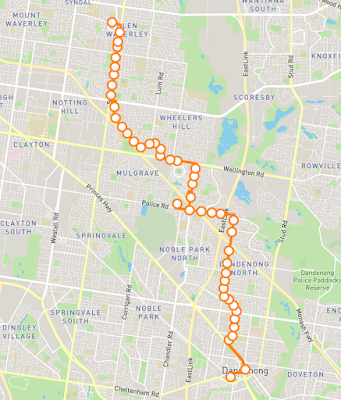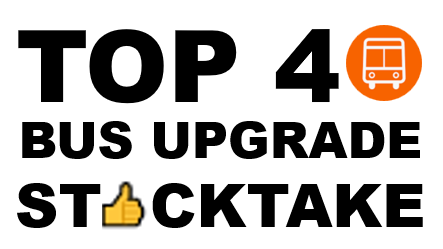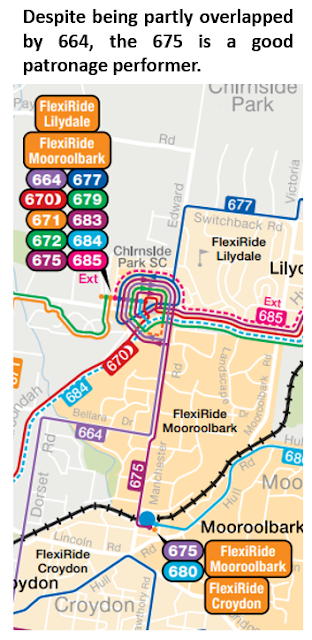Today we're counting down Melbourne's 40 most heavily used bus routes and seeing which have had service upgrades and which are still waiting. Stocktakes like these can be useful to assess progress made and priorities for the future.
Why is this important? Transport usage is supply led. People respond to better service by using it more.
You get that with roads where more people start driving if you widen a road or build a new freeway. The public transport equivalent of that is service frequency. Provided a transit route is sensible the most potent way to boost ridership is to throw more trips on it. Increased population density along a route and busways are nice to have but the key really is service if you want more usage. It's really that simple, as Currie and Delbosc found in their
2010 comparison of bus ridership across four Australian cities.
I'm using 2018 DoT boardings per hour figures to rank each route's usage. These are weekday statistics but weekend numbers are often well correlated except in special cases like university shuttles that don't run then.
Ordering is based on boardings per hour with the highest first. However even bottom listed routes are still highly productive, with 40 boardings per hour. That's double the threshold that Infrastructure Victoria considers makes for a productive bus route. Below them is 300-odd routes that are less highly used than those listed. These include the three orbital SmartBuses, all of which have quieter sections that depress their averages.
Read what I said about the 10 most productive of those routes (using the same numbers) back in 2019 for some background. And about top performing routes in new 'ethnoburbs' here.
The list
Route details in black. My comments in red.
👍👍= major upgrades budgeted or recently implemented.
👍 = minor upgrades budgeted or recently implemented.
🙏= Deserve upgrades but not funded.
601 Monash University (Clayton) - Huntingdale Station. Already very frequent. Corridor gained when Routes 630 and 900 were added to Night Network.
301 La Trobe University - Reservoir Station. Already frequent (every 10 min).
495 Point Cook South - Williams Landing Station. 🙏 Currently only every 40 min most times outside peak. Needs off-peak 7 day upgrades and longer operating hours. Ideally should be on Night Network.
401 North Melbourne Station. Already very frequent. Role will lessen when Metro Tunnel opens.
733 Oakleigh - Box Hill. 👍👍 Currently every 30 - 60 min most times. Needs all day upgrades and extended hours on busy Clayton - Box Hill section. Upgrades funded in 2022 state budget.
529 Craigieburn Station - Craigieburn North. 👍👍🙏 Major upgrades in April 2022 with 20 min weekday service and some longer hours as part of broader network revamp. Needs further longer hours and weekend frequency upgrades.
180 Werribee Station - Tarneit Station. 👍🙏 Upgraded with Night Network service added in 2021. Longer weeknight hours desirable.
167 Tarneit Station - Hoppers Crossing Station. 🙏 A high performing route in 2018 though much of catchment now has new Route 182 nearby. Longer hours desirable.
150 Tarneit Station - Williams Landing Station. 👍 🙏 Upgraded with Night Network service added in 2021. Currently only every 40 min most times. Justifies 7 day off-peak boost to every 20 min and longer weeknight hours.
630 Elwood - Monash University. 👍 🙏 Upgraded with Night Network service added in 2021. Saturday service currently every 30 min and Sunday every 60 min. Very early finish on Sunday. Justifies Saturday and especially Sunday frequency upgrade with later evening finish.
160 Hoppers Crossing Station - Tarneit Station. 🙏 Currently only every 40 min most times. Justifies off-peak boost to every 20 min and longer operating hours.
406 Keilor East - Footscray Station. 👍🙏 Upgraded with Night Network service added in 2021. Every 20 min Monday - Saturday but only every 40 min Sunday. Justifies 20 min Sunday service and longer operating hours.
151 Williams Landing Station - Tarneit Station. 🙏 Currently only every 40 min most times. Justifies 7 day off-peak boost to every 20 min and longer operating hours.
494 Point Cook South - Williams Landing Station. 🙏 Currently only every 40 min most times outside peak. Needs off-peak weekday upgrades and longer operating hours. Ideally should be on Night Network.
170 Werribee Station - Tarneit Station. 🙏 Currently every 20 min daily but could benefit from longer operating hours. Potential BRT/SmartBus corridor due to trip generators.
900 Caulfield - Stud Park SC (Rowville). 👍🙏 Upgraded with Night Network service added in 2021. Given a minor weekend frequency upgrade recently but mostly still half-hourly. Needs upgrade to every 10 min weekday, 10-15 min weekends with weekend upgrade most important.
703 Middle Brighton - Blackburn. 👍 🙏 Upgraded with Night Network service added in 2021. Needs improved operating hours, a more even frequency and more trips.
318 City (King/Lonsdale Sts) - Deep Creek. Peak only commuter route.
192 Werribee Station - Wyndham Vale Station. 🙏 Significant unique catchment to growing area. Currently only every 40 min most times. Justifies off-peak boost to every 20 min and longer weeknight hours.
201 Deakin University - Box Hill Station. 👍👍 University shuttle route less frequent than it should be and duplicated by other routes eg 281 and 768. Upgrades funded in 2022 state budget.
907 City (King/Lonsdale Sts) - Mitcham. 👍👍 🙏Upgraded with Night Network service added in 2021. Received major upgrades with weekend service boosted to every 15 min in 2021. Scope for further upgrades to every 10 min off-peak and evenings boosted to 20 min.
533 Craigieburn - Craigieburn North. 👍👍 🙏 Major upgrades in April 2022 with 20 min weekday service and some longer hours as part of broader network revamp. Needs further longer hours and weekend frequency upgrades.
505 Moonee Ponds - Melbourne University. 👍 🙏 Minor upgrades in previous budget but still only hourly off-peak. Increase to 30 min desirable.
536 Gowrie - Glenroy. 🙏 Very popular 6 day route with limited operating hours. Scope to standardise route alignment also. Needs 7 day service and longer hours.
740 Mitcham - Vermont East. Peak only route with weak terminus. Should run all day in broader network review and revamp.
424 St Albans Station - Brimbank Central SC. 🙏 Low income high bus using catchment. Currently has short operating hours. Upgrade with longer hours and preferably increased frequency.
190 Wyndham Vale Station - Werribee Station. 👍🙏 Upgraded with Night Network service added in 2021. Potential to improve weekend frequency to 20 min.
410 Footscray - Sunshine Station. 👍🙏 Upgraded with Night Network service added in 2021. Every 15 - 20 min Mon - Sat but drops to hourly on Sunday. Upgrade Sunday service to every 20 or 30 min.
508 Moonee Ponds - Alphington. 🙏 major east-west route. Every 20 min on weekdays but drops to 30 - 40 min on weekends. Upgrade weekends to every 20 min and extend operating hours.
737 Monash University - Croydon. 🙏 Major cross-suburban service. Currently frequency only every 30 min weekdays, 40 min weekends. Desirable to increase frequency to 15 min weekday / 20 min weekend. MP.
908 City (King/Lonsdale Sts) - The Pines SC. 👍Upgraded with Night Network service added in 2021.Weekend service reduced from 20 to 30 min in conjunction with Route 907 upgrade to retain connectivity.
570 Bundoora RMIT - Thomastown. 🙏 Significant cross-suburban service. Every 20 min weekdays but 40 min weekends. Desirable to increase frequencies (especially for Saturday) and extend operating hours.
893 Dandenong Station - Cranbourne Park SC. 🙏 Major cross-suburban service. Good frequencies but needs more operating hours including earlier starts (especially weekends) and later finishes. Possible to do this economically by spreading some trips out, notably on Sunday.
237 Fishermans Bend - City. 👍 Monday - Friday only service to proposed development area. Upgrades budgeted but not delivered.
302 City (Lonsdale St) - Box Hill. 🙏 Popular route that doesn't meet minimum standards re operating hours. Slightly increase operating hours and boost Sunday service (with related 304). .
497 Williams Landing Station - Saltwater Coast Estate. 🙏 Significant unique coverage in new estate. Every 40 min off-peak. Desirable to extend operating hours and boost interpeak patronage.
813 Dandenong - Waverley Gardens SC. 👍🙏 Upgraded from every 60 to every 40 min weekdays. Welcome but didn't go far enough with at least southern catchment justifying a 20 min frequency. Could benefit from longer hours and further network reform. More here.
423 St Albans Station - Brimbank Central SC. 🙏 Low income high bus using catchment. Currently has short operating hours. Upgrade with longer hours and preferably increased frequency.
537 Craigieburn Station - Craigieburn West. 👍👍 Major upgrades in April 2022 with 20 min weekday service and some longer hours as part of broader network revamp.
814 Dandenong - Springvale South. 🙏 High usage route only every 60 min. Limited hours with no Saturday afternoon or Sunday service. Extend to minimum standards and increase frequency.
279 Box Hill - Doncaster SC/Templestowe. 👍👍 Major upgrades commenced in September 2021.
270 Box Hill - Mitcham. 👍👍 Major upgrades commenced in September 2021.
There's actually 42 routes listed. This is because No 41 and 42 attracted a still strong 40 weekday boardings per hour and I thought it fair to include them.
The three SmartBus orbitals (901, 902, 903) are notable omissions. Sections of them are very busy but quieter portions depress productivity overall. However if split (as I suggested here) then their busier parts would easily make top 40 and possibly top 20 in passenger boardings/km.
Routes that got service upgrades
Five routes (301, 318, 401, 601, 740) have neither had recent upgrades nor any suggested by me. All are either already frequent university shuttles or peak only routes.
Six of the remaining 37 routes (270, 279, 529, 533, 537, 907) got recent major upgrades. A further two (201, 733) have what I believe to be major upgrades budgeted.
Another ten of the 37 (150, 180, 190, 406, 410, 630, 703, 813, 900, 908) have had what I've termed minor upgrades. All but the 813 can be attributed to the 2021 Night Network reforms that introduced 24 hour weekend service on regular bus routes. As well as benefiting 'night owl' travellers these delivered much needed earlier weekend starts on popular routes. Two more routes (237 and 505) got funding for upgrades - I believe minor - in the 2021 state budget.
All this means that about half of our 40-odd best used bus routes have had some sort of service upgrade in the last three years or so. The two biggest initiatives were two upgrades in 2021 (Transdev timetable reforms and the new Night Network) and one in 2022 (new Craigieburn network). Some other routes also got upgrades but aren't mentioned today as they missed the top 40 tally.
Routes that didn't
The above is the glass half full summary. Which top performing routes have got nothing lately? These number around 17.
About half are in the City of Wyndham with routes like 151, 160, 167, 170, 192, 494, 495 and 497. All but 170 have a 40 minute interpeak frequency despite usage and catchment that justifies service nearer to 20 minutes and some extended operating hours. As peak frequencies are typically already about 20 minutes these upgrades just need more drivers and the existing fleet to be worked harder.
Moving north west and north there's 423 and 424 around St Albans and Glenroy's 536. These serve low income catchments with a high propensity to use buses but without matching service. All three would be very cheap upgrades being short routes needing some extra operating hours, and, for 536, Sunday service.
Also in the north are the east-west 508 and 570. These provide important circumferential connections between trains and trams. Both are every 20 minutes on weekdays but drop off greatly on weekends. Extra operating hours would also be desirable.
The remaining three are in the east and south-east with 302, 737 and 814 being either busy corridors or having high usage due to favourable local demographics. 302 (along with 304) could benefit from longer operating hours and a Sunday upgrade, 737 needs a weekend upgrade and longer hours while 814 is the runt of the litter, currently not running on Saturday afternoons and Sundays. It's also only hourly when it does run, including during peaks.
Routes that only got Night Network upgrades
I mentioned before routes that got operating hours upgrades as part of Night Network but not frequency upgrades at other times. The City of Wyndham leads with three (150, 180 and 190). 180 and 190 run every 20 minutes at least on weekdays while 150 is only every 40 minutes off-peak. Given its large unique catchment this route is most deserving of a service boost then.
The remaining four are in the inner west (406 and 410) and south-east (630 and 703). The biggest need for all four are weekend frequency upgrades along with some increases in operating hours. 406 and 410 are particularly notable (and cheap to upgrade) as they have good Monday - Saturday day frequency but need upgrades in the evenings and on Sundays were frequency can be as low as 60 minutes (for 410).
These seven routes gained welcome extra trips as part of last year's Night Network upgrades but not at any other time. This is despite many more people being out at 2pm on a Sunday versus 2am on a Sunday. Their full patronage potential will only be realised if extra trips are added off-peak, particularly weekends.
Already upgraded routes that justify more
Finally we come to popular routes that got some upgrades but deserve more. These are all high productivity routes whose upgrades fixed some problems but not all.
For example Craigieburn's 529 and 533 got their off-peak weekday frequency doubled to 20 minutes but have weekend timetables stuck at every 40 minutes. 813 went from 60 to 40 but should have been every 30 minutes minimum and preferably 20 minutes (its passenger catchment is that good).
900, past Chadstone, justifies a weekend frequency nearer to 15 min than the lumpy 20 - 30 minute service it currently has. Doncaster Road's 907 is another excellent performer that could do with higher frequency for more of its long span. 505 got only a small upgrade budgeted but its strong patronage productivity indicates an appetite for more.
Summary
Today we've run through Melbourne's 40 most productive bus routes. Many had beneficial upgrades, especially as part of Night Network and other reforms during 2021. But too many still only run every 30 to 60 minutes during popular shoulder and off-peak times, notably weekends, when many are travelling.
You might accept such infrequency on a neighbourhood bus route in a low needs area. However it doesn't make sense on our best used routes where there's a clear appetite for more.
Upgrading their frequencies to every 20 minutes or better seven days would make for a much stronger and useful bus network more would choose to use. And it would be particularly cost-effective as all would involve adding driver and bus operating hours without needing to buy new buses.
Other Building Melbourne's Useful Network items are here




































